Three possibilities arise: |
||
| Case 1: Normal good | Case 2: Inferior good | Case 3: Giffen good |
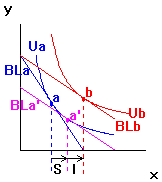 |
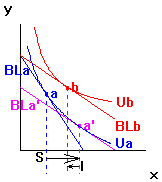 |
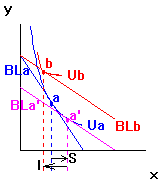 |
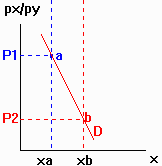 |
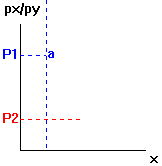 |
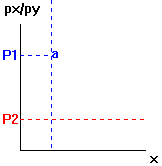 |
Substitution and income effects
(Available online: Substitution
and income effects: alternative possibilities (Java))
Consider an individual who consumes two goods, x and y. Suppose the price of x
falls. This price decline will influence the individual's consumption of x in two ways:
1. THE SUBSTITUTION EFFECT: The consumer will
have an incentive to substitute the now relatively cheaper x for the relatively more
expensive y, consuming more x and less y until the relative value of x equals the new,
lower opportunity cost of x.
Fall in Px/Py => fall in optimal MRS (= MUx/MUy).
The substitution effect answers the question: What would happen to your
consumption of x if its price changes and your real income (utility) is held
constant instead of your money income?
2. THE INCOME EFFECT: The individual will adjust consumption
of x in the process of moving to a higher attainable level of utility at the new, lower
price of x.
Fall in Px/Py => increase in attainable U.
The income effect answers the question: What will happen to your
consumption of x as you move to a new level of welfare (utility) as a result of a price
change?
Three possibilities arise: |
||
| Case 1: Normal good | Case 2: Inferior good | Case 3: Giffen good |
 |
 |
 |
 |
 |
 |
For normal goods, the substitution
and income effects reinforce each other. For inferior goods, the income effect offsets
part of the substitution effect. Giffen goods are an extreme case of inferior goods in
which the income effect actually overwhelms the substitution effect.
The left-hand diagram in the bottom row illustrates the consumer's
demand curve for good X.
Diagram the demand curve for the cases of inferior and Giffen goods
illustrated above.
Can the demand curve for a normal good ever slope up? Why or why not?
Can the demand curve for an inferior good which is not a Giffen good ever
slope up? Why or why not?